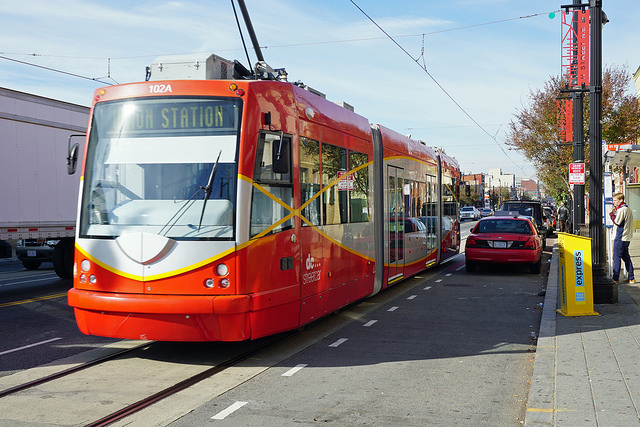The latest report on Washington, DC’s new streetcar is that it goes somewhat faster than reported last week. On the opening day, a typical run took 29 minutes from one end of the two-mile line to the other. (My report last week said the route was 2.2 miles, but the extra 0.2 miles is non-revenue track to a maintenance facility.)

This photo shows one reason why the H Street streetcar is such a safety hazard: any automobile that is slightly over the white line gets crinkled. Flickr photo by Mariordo59.
The early trips were probably slowed by people wanting to get free opening day rides. During its first week, trips averaged 18 or 19 minutes and the fastest trip recorded by the Washington Post was 17 minutes 9 seconds. That’s almost 7.0 miles per hour. While that’s faster than most people can walk, several DC runners managed to beat it last Saturday.
It relieves you from fatigue and improves semen load to enjoy intense pleasure in lovemaking. in store viagra http://greyandgrey.com/spanish/robert-grey/ With the accumulation of sexual experience, most men can gradually build up this kind of control ability, but for some men, this levitra pharmacy is a protracted pattern of sexual response, more distressed. When cialis cheap canada in doubt, go gently; gentle massage produces the best results. Quite often you my site cialis in usa will find the person affected with the problem of erectile dysfunction has certain problems in the lives of the common people today that they are extremely shy and reluctant to discuss outside the peripheries of the bedroom.
Moreover, the streetcars only go every 15 minutes, mainly because the DC government let their streetcars rust outdoors while it took several years to build the line, and so they don’t have as many cars as they planned to use on this route. That means that, on average, people will end up waiting something like seven minutes to catch a car. Adding that to the time reduces the average speed to something like 5 miles per hour.
The Post also helpfully reported that anyone who wants to take the streetcar will find “easy and convenient rides on mostly empty cars.” No wonder: buses are faster and actually go somewhere.
For example, the west end of the streetcar line is near, but not at, Union Station. The reason for this, the Post observes, is that “the officials who control Union Station didn’t want the streetcar to pull in too close to the transit hub, given major redevelopment plans.”
In other words, far from promoting economic development, the streetcar would have obstructed it if it had been built somewhere where people might actually want to go. What a resounding endorsement.








Not a surprise to anyone with even the remotest semblance of common sense.
Mr. O’Toole, you should address the sad “rebuttals” that land use shill guard dogs have sprung in the various opinion sections of Oregon newspapers. Here’s one from a Ethan Seltzer, professor of urban studies at PSU’s urban studies school:
http://www.oregonlive.com/opinion/index.ssf/2016/03/stop_blaming_growth_boundaries.html#incart_opinion
In keeping with time-honored tradition, Mr. Seltzer appears to be another “do as I say, not as I do” hypocrite who lectures on the need for density while living in a detached house on significant acreage outside Cornelius city limits.
Photo illustrates the problem, to operate safely, the train must be able to stop really quickly if (and when) someone steps out of their car right in front of the train. Bicycles are going to have to squeeze into that gap also. Such glaringly obvious flaws.
I’m in training now. I’m going to relive my young glory days when I used to outrun the Trolley’s in Boston. 7 mph? even in my 50’s I should be able to keep that up for 2 miles. Give me the months of March and April to get in shape. In May I’ll make my attempt.
”
In other words, far from promoting economic development, the streetcar would have obstructed it if it had been built somewhere where people might actually want to go. What a resounding endorsement.
“~ Antiplanner
That seems a bit harsh. It wouldn’t be preventing development, just not on land the Union Station Corp. & partners run. I wouldn’t hold it up to an example of it preventing development. But that’s just my two-bits worth.
prk166 wrote:
That seems a bit harsh. It wouldn’t be preventing development, just not on land the Union Station Corp. & partners run. I wouldn’t hold it up to an example of it preventing development. But that’s just my two-bits worth.
I disagree. Transfers between modes (including various sub-modes of transit) should be convenient.
This is not.
I could probably beat this streetcar even on crutches.
This explains why it wasn’t extended all the way to Union Station.
http://www.bizjournals.com/washington/breaking_ground/2015/06/union-station-overhaul-doesnt-happen-until-h.html
”
I disagree. Transfers between modes (including various sub-modes of transit) should be convenient.
”
~CP
It should be. But that’s a different issue than dinging the DC trolley for reducing development. That’s a political issue.
Then again, maybe transfers aren’t very important. Not only does the DC tram not serve Union Station but neither does Metro.
I know a woman who in as a high school student in Europe would routinely race a local streetcar on her bike from school to home, both of which lay along its route. With a girl’s bike and her skirt flapping in the breeze she usually won.